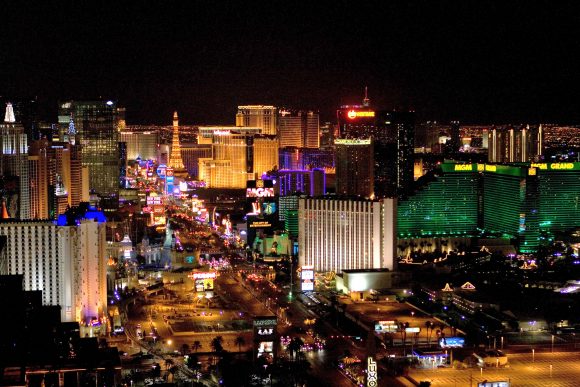
On Oct. 1, 2017, the world was stunned by news of the deadliest mass shooting in U.S. history. (lasvegaslover/Wikimedia Commons)
Opinions do not necessarily represent CUIndependent.com or any of its sponsors.
When I was growing up, my family had an organic garden in our backyard. We dutifully tended to our plants — cilantro, soybeans, empty heart vegetable, asparagus, bananas, lychee, mango, starfruit and papaya — and the Hawaiian rain and volcanic soil provided growth and grounding for this food. But I remember once eating a papaya and getting sick afterwards; I didn’t know what caused my discomfort. It didn’t occur to me that something I had grown and looked after could make me so ill.
. . .
Fifty-nine Americans lost their lives Sunday night — 58 victims, 1 terrorist — but what was also lost was another opportunity to interrupt the narratives about terrorism, race and mental health that soil discourse about structural illness.
Of the 91 mass shootings carried out in the past 35 years, 56 percent were done by white men, according to Mother Jones. Dylann Roof took the lives of nine black church-goers of Emanuel African Methodist Episcopal church. James Holmes killed 12 people in an Aurora movie theater. Adam Lanza killed 28 — children, teachers, his mother and himself — at the Sandy Hook elementary school.
The discourse surrounding those events is the same — he was acting alone, he had no terrorist ties, so what could have possibly been the motive? Investigators face the difficult task of finding motive behind Stephen Paddock’s massacre after concluding that he had no ties to foreign terrorist organizations. Dominant discourse around these tragedies resists to recognize homegrown terrorism because these events do not match what we expect to see when we think of terrorism.
Jon Stewart hit the nail on the head with his emphatic monologue following the South Carolina Emanuel AME church massacre. He speaks to America’s self-imposed blindness.
“And we’re going to keep pretending like, ‘I don’t get it. What happened? This one guy lost his mind.’ But we are steeped in that culture in this country and we refuse to recognize it, and I cannot believe how hard people are working to discount it … We’re bringing it on ourselves. And that’s the thing. Al-Qaida, all those guys, ISIS, they’re not s— compared to the damage that we can apparently do to ourselves on a regular basis.”
Searches for Stephen Paddock and “motive” far surpass searches for his “terrorism.” The media and law enforcement agencies tend to quickly dismiss conjecture about white mass shooters having terrorists affiliation; the aftermath of Las Vegas was no different, though ISIS wanted to claim responsibility. With terrorism crossed off the list of possible motives, the country is left wondering what could have possibly caused your average Joe to open fire on a country music festival.
You know when you’re playing with a kid and you pretend you can’t find them? That’s the sort of badly-masked, play-ignorance we are actively toying with. But we know damn well that there are consequences for not recognizing what is really happening here. The rampage shootings of Las Vegas, Orlando, Charleston and San Bernardino all fall under the same definition of terror, but we are refusing to admit it.
Articles about the Orlando nightclub shooting, attacks in Benghazi and the Iran nuclear deal are housed under a section of Fox News’ website labelled “Terror.” Last Sunday’s shooting is housed under “Crime.”
In protecting Paddock and other shooters from the label of “terrorist,” white Americans are able to segregate their image from the brown image of terrorism that they have created. Some suggest that white shooters commit these acts because of triple entitlement, but of course American society won’t identify that as a problem.
In America, terrorism is a collective Muslim activity. In contrast, white shooters are lone-wolf gunmen who work freely, have no ties with the community and do not represent the rest of society. White shooters are troubled anomalies, shooters of color are brainwashed, perhaps thugs, fighting for an immoral cause and representatives of their culture.
What this does is preserves white virtue — these “lone-wolf” shooters are an exception that do not define the race. If anything, we are told to extend sympathy to their mental illness (or at least their families) and focus efforts on supporting troubled youth. Of course, this narrative relies on an opposite construction of what the same acts mean when carried out by others.
By evoking these different discourses around the people who commit acts of evil, we create an imagined but significant difference between these supposed types of evil. Not only have we created a tale of who can be capable of terrorism, but we’ve also decided who can be the victim. Those people, respectively, are: non-white people, white people. Playing up white victimhood is essential to distance that group from the identity-marring label “terrorist.” This narrative further individualizes white evil as a personal mental health problem versus a structural problem in which these evils take place.
No one is going to call it terrorism and no one is going to call this white-on-white crime. We invented terrorism, outsourced it and are now offended that it is being produced in the homeland. Same act, different face, different story.
Because if we identity these shooters as terrorists, then we must also identify the terrorist organization they are operating under.
Terrorism is here, it is home-grown and it is making us sick.
Contact CU Independent Opinion Editor Hayla Wong at hayla.wong@colorado.edu.
